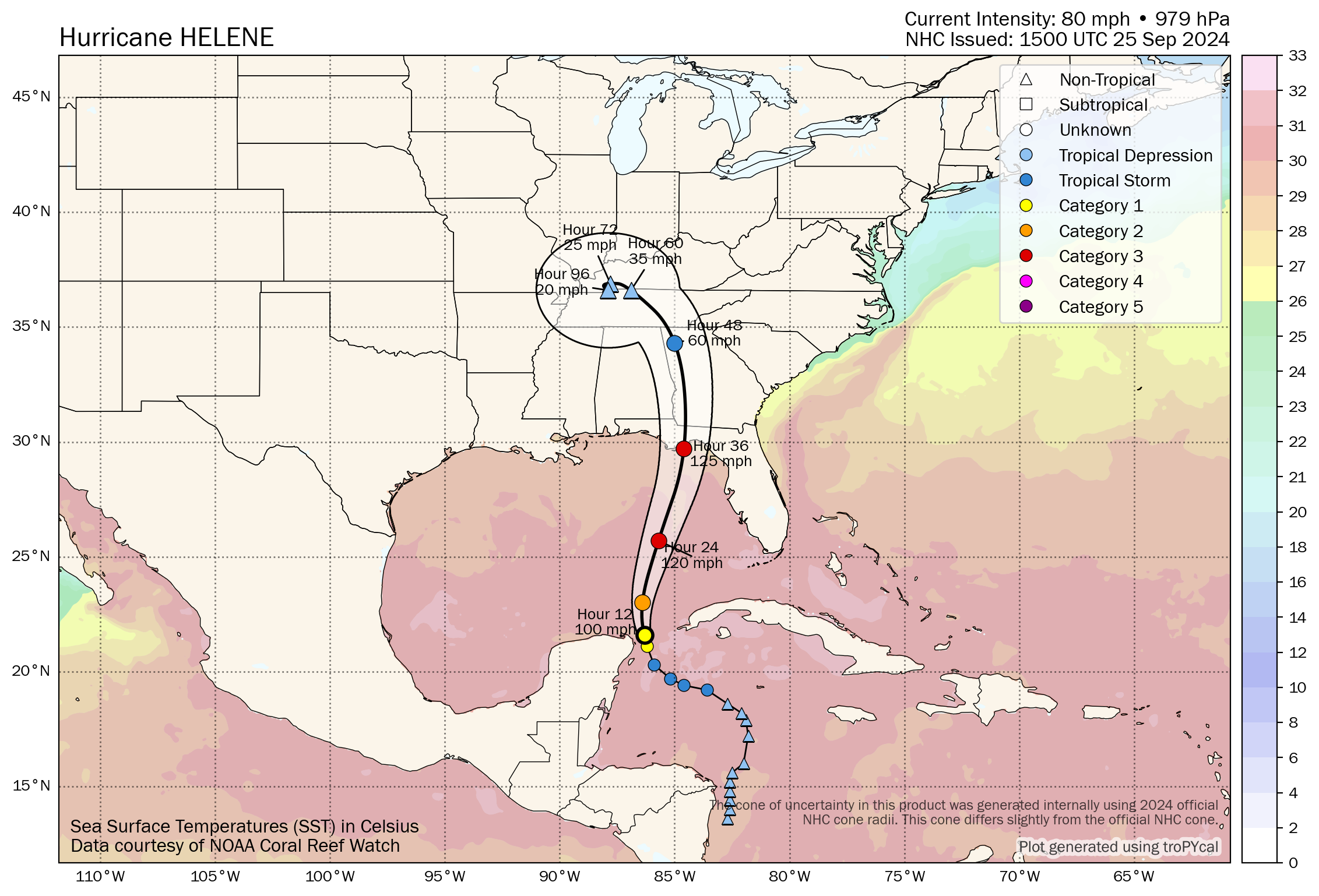"Catastrophic and Potentially Unsurvivable" Major Hurricane Helene Set to Make Landfall in Florida Late Thursday
/Satellite Image of Hurricane Helene from September 26th at 2:02Pm EDT, Courtesy of Tropical Tidbits.
Hurricane Helene continued its intensification overnight, strengthening to a Category 2 Hurricane this morning and then to a Category 3 Hurricane this afternoon, with a clearly formed eye and estimated sustained wind speeds of 120mph (195km/h). Tropical storm-force winds are already being felt across Southwest Florida along with storm surge causing inland flooding in coastal communities. The storm will continue to strengthen throughout the day and pick up speed as it makes its final approach for landfall along the Big Bend Coast as a Major Hurricane.
There has been little change to the forecast track from the National Hurricane Center (NHC) over the last 24 hours. Hurricane Helene made its projected north-northeastward turn and it will continue along that track before making a final turn northward this afternoon before landfall later this evening.
While the exact location of landfall remains unclear, it appears that will occur in Apalachee Bay. The NHC has stated that in comparison to previous hurricanes in the Gulf of Mexico in the past decades, Helene is on the larger size and as such, its impacts will be very widespread, especially on the east side of the eye. While the massive wind field will bring tropical storm-force winds across the entire state of Florida, hurricane-force winds will be within the eyewall, along the Big Bend Coast, arriving slightly ahead of landfall this evening. These devastating hurricane-force winds are expected to be at least 120mph (195km/h) sustained with even stronger gusts expected.
Inundating rainfall causing widespread flooding is also a major concern with Hurricane Helene across Florida with over 5 inches (127mm) of rain expected along the Big Bend Coast and 2 inches (51mm) along the rest of the Gulf Coast of Florida, with lesser amounts further inland. Rainfall totals in the Apalachicola region could easily exceed 8 inches (203mm).
Along with intense winds and flooding rainfall, the biggest threat will be, to quote the NHC “catastophic and potentially unsurvivable storm surge”, particularly for the Apalachee Bay. The storm surge has already started to appear throughout the entire Florida Gulf Coast and the water levels will continue to increase as Hurricane Helene makes its final approach. Peak storm surge levels exceeding 10ft are expected from Apalachicola to Chassahowitzka and up to 20ft is possible from Carrabelle to Suwannee River.
These factors all combined have prompted widespread Hurricane and Tropical Storm Warnings, evacuations, and States of Emergencies throughout the entire state of Florida and beyond.
Forecast Track for Hurricane Helene, Courtesy of The National Hurricane Center.
With the speed and strength that Hurricane Helene will continue to gain, its impacts will be felt deep inland into the Southern Appalachians with damaging winds and intense rainfall.
Tropical storm-force winds are expected throughout Georgia and into the higher terrains of the mountains which will easily bring down trees and power lines, resulting in widespread power outages, as well as damage to property.
The Blue Ridge Mountains and Piedmont Region of Northern Georgia, Eastern Tennessee, and the Western Carolinas are also possibly looking at receiving up to 15 inches (381mm) of rain by the end of the weekend as the storm is expected to stall beginning late Friday over the Tennessee Valley. This much rain will bring a high risk of urban and flash flooding and landslides across the region. Meteorologists have already started to compare this to the 1916 flooding event in the Asheville, South Carolina area and impacts are expected to be greater than those from Tropical Storm Fred in 2021 and Hurricanes Frances and Ivan in 2004.
Helene will remain in an ideal environment for continued strengthening as it makes its final approach before landfall. It’s still located in an area with relatively low shear, strong upper-level divergence, as well as 30°C sea surface temperatures and warmth that extends deep below the surface. These conditions will allow the storm to further intensify from its current strength to a like high-end Category 3 Hurricane with isolated Category 4 level wind gusts.
There is still a bit of time before the storm hits to take necessary precautions to protect life and property. If you or your loved ones are in the path of the storm, please heed all directives from emergency personnel and stay safe!
Forecast Track and Intensity of Hurricane helene with Sea Surface Temperatures, courtesy of Tomer Burg.






















































